Homo floresiensis › A Visual Glossary of Greek Pottery » Ancient origins
Articles and Definitions › Contents
- Homo floresiensis › Ancient History
- A Visual Glossary of Greek Pottery › Antique Origins
Ancient civilizations › Historical and archaeological sites
Homo floresiensis › Ancient History
Definition and Origins
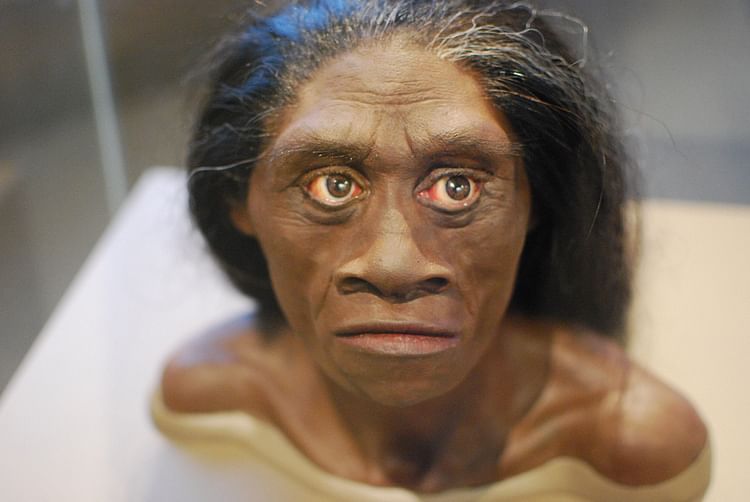
Homo floresiensis, nicknamed 'hobbit' because it only stood about 1 meter tall, is an extinct species of fossil human that lived on the island of Flores, Indonesia during the Pleistocene. Floresiensis is still shrouded in a fair bit of mystery. First excavated at Liang Bua Cave in 2003 CE, these humans were originally thought to have lived between c. 74,000- c. 12,000 years ago, which would have made them the last surviving humans besides our own species of Homo sapiens. Recent evidence suggests, however, that these humans were actually quite a bit more ancient: their bones now come in at between around 100,000 and 60,000 years ago, and the tools found alongside them range between c. 190,000-c. 50,000 years old.There are a lot of things we do not know about Homo floresiensis as of yet, including the species' exact ancestry, which is still riddled with holes.
LOOKS & LIFESTYLE
These tiny people are by now known from over 100 bits and pieces that belonged to something between 9 and 14 individuals, all found at Liang Bua Cave. The type specimen (LB1) is a partially complete skeleton that is suggested to have been around 106 cm tall, while the rest of the individuals may have been a bit smaller still. Compared with other humans who lived around the same time, such as the Neanderthals (who come in at a rough average of 165 cm) and our own tall Homo sapiens, Floresiensis thus had a very different vantage point indeed.
Matching their small bodies, the only skull that has been found - belonging to the LB1 specimen - shows a brain size of around 426 cm3 (compared with roughly 1300 cm3 for Homo sapiens today). The skeletons of Homo floresiensis show a weird mosaic of features, some of which are more modern and others which are quite primitive; for instance, it had short legs in proportion to its arms, large feet (funnily matching its hobbit nickname), primitive wrist bones, but more relatively modern thumbs.
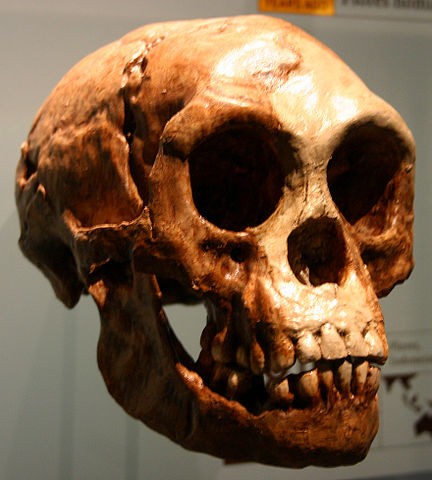
Homo Floresiensis Skull
Homo floresiensis survived by hunting and gathering on an island that showed clear signs of being quite isolated and happy doing its own evolutionary thing. Some small mammals had grown larger than their mainland siblings, whereas some of the larger ones show dwarfing, like the dwarfed Flores-version of the Stegodon - an elephant-like creature which seems to have been hunted by Floresiensis. Also present were komodo dragons, giant rats, and creepy, carnivorous birds like the massive 1.8-metre tall marabou stork. Although Homo floresiensis had fairly advanced stone tools and is thought to have known fire - which would have helped them deal with all of this stuff - the more symbolic or modern vibes that come through evidence of burials or personal ornamentation are completely absent.
UNEARTHING THEIR ORIGINS
Over the past decade, a whole cascade of theories has been proposed to explain who Homo floresiensis ' ancestors were.Initially, there were three main ones that popped up most frequently. The first was that Homo floresiensis evolved from Asian Homo erectus and then became dwarfed after arriving on the island (dwarfism occurring on isolated islands is not unheard of); the second was that they stemmed from an early species of Homo with roots in Africa, such as Homo habilis ; and thirdly, it was thought they may have been early Homo sapiens struck by some sort of disease or disorder. Frustratingly, these theories either could not properly explain all the hobbit's characteristics, or suffered from a lack of data available to push the balance in either one of these theories' favour.
HOMO FLORESIENSIS HAD SHORT LEGS IN PROPORTION TO ITS ARMS, LARGE FEET, PRIMITIVE WRIST BONES, BUT MORE RELATIVELY MODERN THUMBS.
Recent studies (see, for instance, Argue 2017) are shining some light into this murky muddle, though. New data suggests that Floresiensis seems to indeed be linked to an early Homo lineage rooted in Africa (more than 1,75 million years ago) and is either a sister species to Homo habilis specifically or sister to a group that spans at least Homo habilis, African and Asian Homo erectus, and Homo sapiens (and is at a similar evolutionary grade to Homo habilis ). Floresiensis ' ancestors must have left Africa in an, as of yet unknown, migration event, which may even have predated or almost coincided with the first steps of Homo erectus out of Africa, who are generally seen as the first Homo to have taken the plunge.
In this new scheme, Homo floresiensis is shown to not be closely related to Homo erectus or Homo sapiens specifically, and because of this distance to Homo sapiens the whole cry proposing that Floresiensis was a diseased form of Sapiens – which was already having significant trouble explaining the whole story – now seems to have landed out of the frying pan and into the fire.
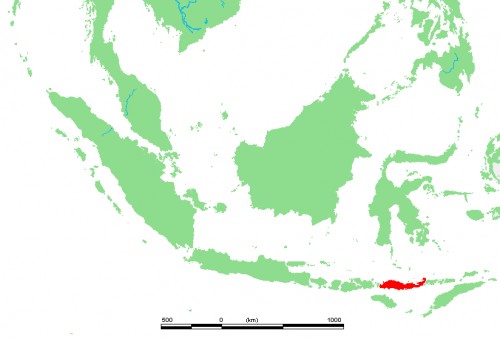
Location of the Island of Flores, Indonesia
Despite this clarification, there is still a huge gap between these early Homo ( habilis ?) living in Africa over 1,75 million years ago, and Floresiensis skeletons being present on Flores in Indonesia between c. 100,000-c. 60,000 years ago (alongside tools ranging between around 190,000-c. 50,000 years old). The only possible stepping stone so far was unearthed in 2016 CE, at the site of Mata Menge, situated on Flores at a distance of 74 km from Liang Bua Cave where the Floresiensis specimens were discovered. A piece of jaw and some teeth found there have turned out to both be a whole lot older than the Floresiensisspecimens, coming in at around 700,000 years old, as well as astonishingly being about 20% smaller than the hobbits. These fragments are thus decent candidates for being the ancestors of Homo floresiensis, and if this is true, their lineage must have travelled from Africa at least once sometime between their early appearance there to landing on Flores by at least c. 700,000 years ago.
QUESTION MARKS
Besides the obvious gaps in their lineage, there are more loose ends to the hobbit's story. When their ancestors went on an adventure out of Africa at an unknown point in time, there was not only a long journey standing between them and the island of Flores; the island was inconveniently surrounded by enough water so that a simple swim would not have sufficed. It has been proposed that a tsunami or other sudden displacement of water may have swept the Floresiensis lineage from nearby places such as Sulawesi onto the green shores of Flores, and for now, this idea seems to hold a tentative consensus in explaining this bit of mystery. Furthermore, were these people who arrived on the island already quite tiny, or did they grow small in its isolation (which seems plausible, but how do the c. 20% smaller Mata Menge fossils fit into this equation?)?
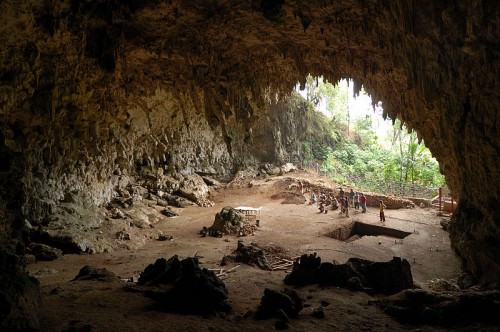
Liang Bua Cave
On the island itself there are obviously huge gaps in the hobbits' timeline, too, and we really only know the big picture – it is hard to fill in many details regarding this species' lifestyle. We also do not know exactly when they disappeared, as the lack of evidence dated beyond c. 50,000 only demonstrates that as of yet we cannot trace their existence past that point, but not that they definitely did not live for a while longer still. Furthermore, even with a date of c. 50,000 in the back of our heads, that sets Floresiensis up for having a potentially overlapping time frame with both Homo sapiens and the Denisovans in south-east Asia.Recent discoveries have shown that early modern humans made it to the more westerly Indonesian island of Sumatra between c. 73,000 and c. 63,000 years ago, and a human presence has now also been uncovered in the north of Australia dating back to around 65,000 years ago, so it is not such a strange scenario to picture these early bands of humans traversing Indonesia and bumping into the hobbits. Without any direct evidence for this, though, it remains an open question whether or not they actually met.
It might take a good while to solve this Homo floresiensis -shaped puzzle to a higher degree. But when (or if) we do, their story has the potential to add a very interesting, perhaps even overturning, aspect to the clearly complex evolutionary path of Homo. After all, the work by Tolkien that matches these people's nickname has a sequel, too.
A Visual Glossary of Greek Pottery › Antique Origins
Ancient Civilizations
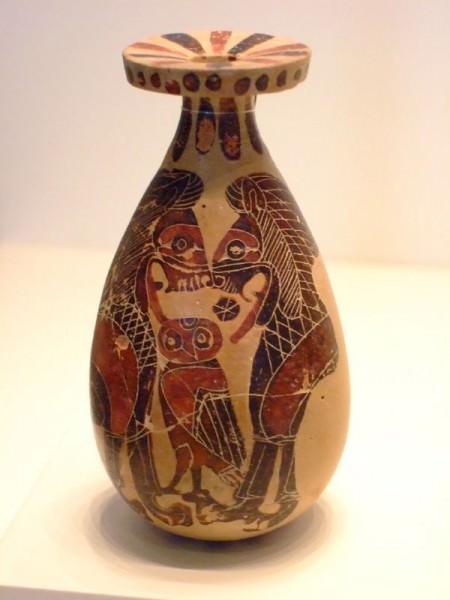
Corinthian Alabastron Vase
Alabastron ( pl. alabastra) - a small jar for storing perfumes, named after the material (alabaster) the first examples were made from. They were often carried by a string looped around the neck of the vessel.
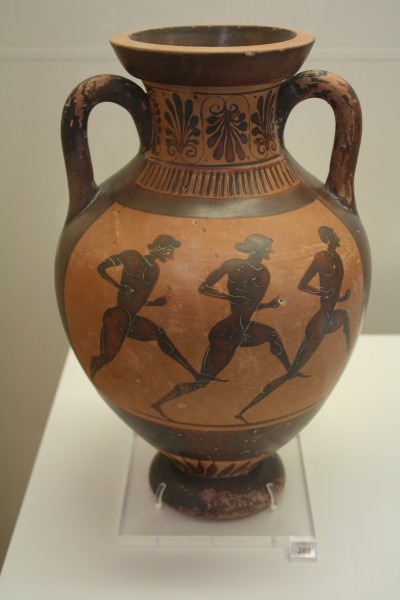
Greek Foot Race
Amphora ( pl. amphorae ) - one of the most common forms in Greek pottery, various shapes, always with two vertical neck-handles and used for storing and transporting oil, wine and foodstuffs such as olives. Often with a lid but these have rarely survived.
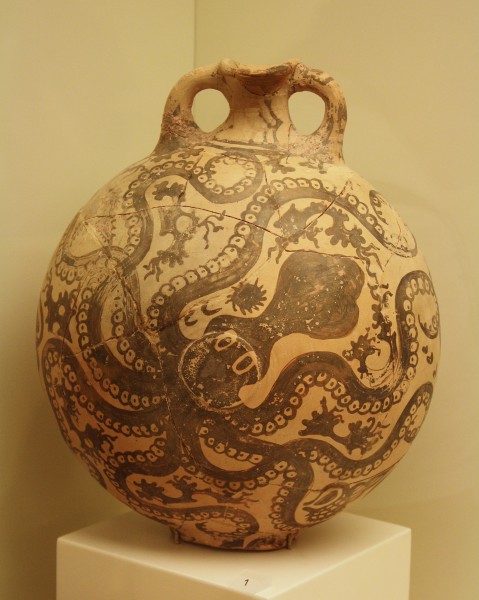
Minoan Vase in Marine Style
Askos ( pl. askoi) - named after the wineskin which it resembles in shape. The small neck implies they were used for pouring liquids in a small quantity, eg: fine oil, honey and vinegar.
Astragalos ( pl. astragaloi) - a vessel shaped like a knucklebone from which it takes its name and which may have been used to store sheep knucklebones which were used as gaming pieces or dice.
Barbotine Ware - a style of pottery with decorative excrescenses.
Bell-Krater - a particular form of the krater vessel with a body shaped like an upside down bell, the handles are placed high on the vessel and the foot is stepped.

Hercules & The Nemean Lion
Black-Figure Style Decoration (c. 620 - c.530 BCE) Invented in Corinth, the style was adopted in Attica to become the dominant style in Greek pottery. Figures were painted in black silhouette with details such as muscles and hair incised using a sharp instrument.
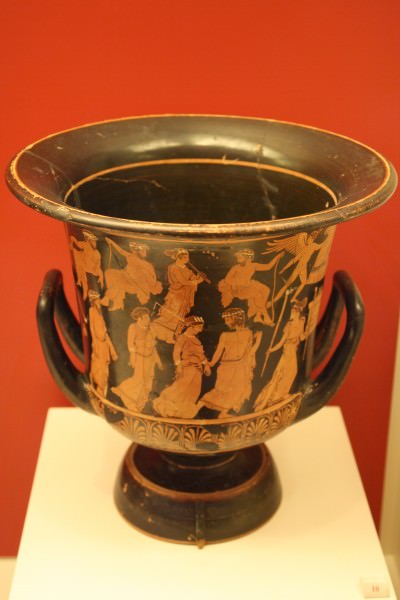
Calyx Krater
Calyx Krater - a krater with a body shaped like a flower calyx, usually with a stepped foot.
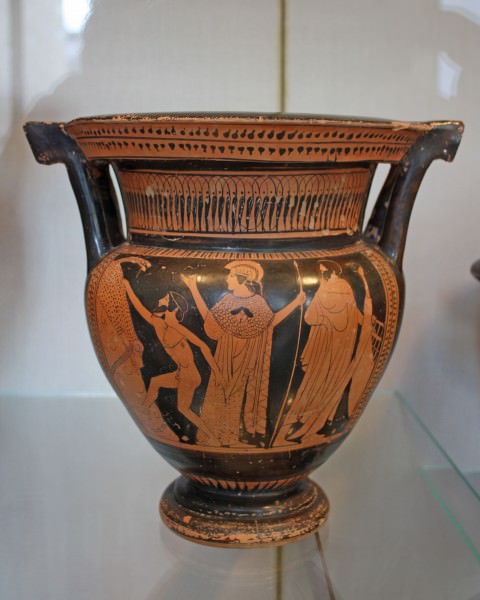
Attic Column-Krater
Column -Krater - a type of krater (wine and water mixer) popular in the black-figure style with each handle supported by a short vertical 'column'.
Dinos ( pl. dinoi) - a large round-bottomed bowl with no handles and used for mixing wine with water. Usually placed on a ceramic stand or metal tripod.
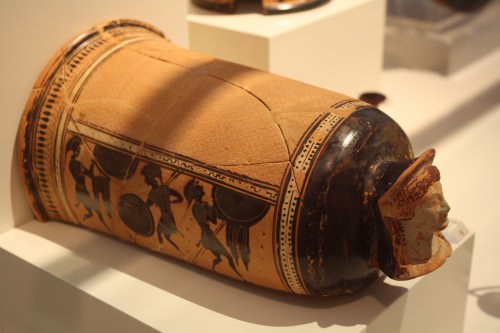
Epinetron
Epinetron ( pl. epinetra) - a half-cyclinder worn over the thigh with the closed end over the knee, used for preparing wool for weaving. The upper surface was often incised to make a rough surface against which the wool fibres could be rubbed. Often with a female head at the closed end.
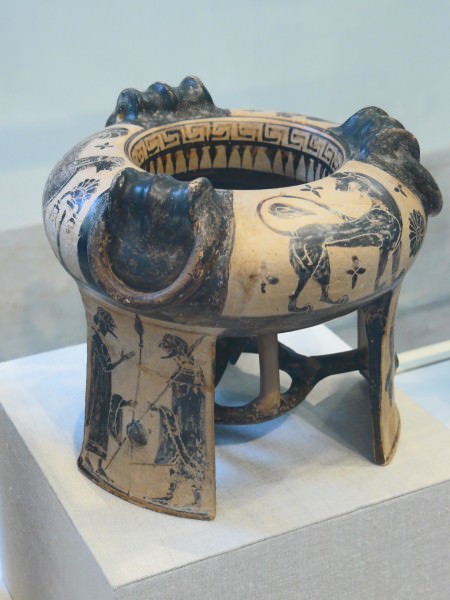
Boeotian Exaleiptron
Exaleiptron ( pl. exaleiptra) - a vessel used to store fine oil or perfume with an inverted lip to prevent spillage and usually lidded. Pottery decoration show them in a context of women bathing or during funerary rites. Also known as a kothon.
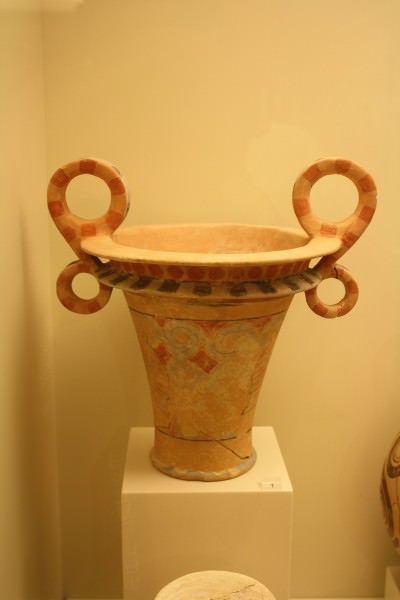
Minoan Vase
Figure-of-eight Vase - named after the distinctive handle shape, from the Minoan civilization.
Fish Plate - a flat dish with a short foot used for serving fish and seafood. A central depression collected excess oil. Produced from the 4th century BCE they were popular in Attica and Magna Graecia. Usually decorated with fish and sealife, fish on Attic dishes were almost always painted with their undersides towards the outer edge whilst those from southern Italy had their undersides towards the centre of the plate.
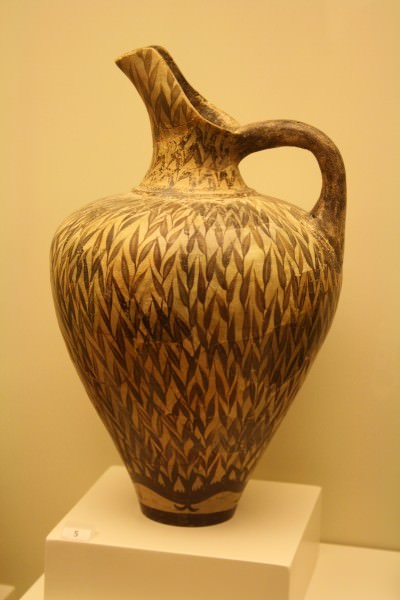
Minoan Clay Jug in Floral Style
Floral Style Decoration - a decorative style from Minoan Crete using plant and flower motifs (c. 1600 - 1450 BCE).
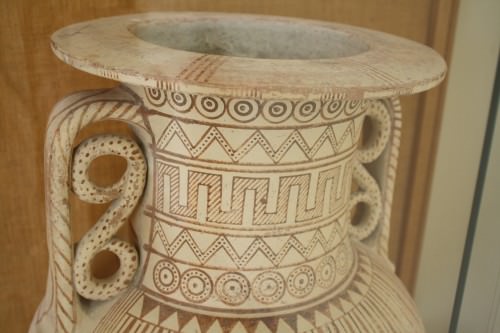
Geometric Pottery Designs
Geometric Style Decoration - the use of simple shapes and lines, later with stylized figures of animals and humans (900-600 BCE).
Graffito ( pl. graffiti) - A mark incised into the vase (usually under the foot), most commonly letters or numbers but sometimes also words and short phrases. They may indicate prices, trademarks or ownership. Simliar marks, but painted, are called dipinto.
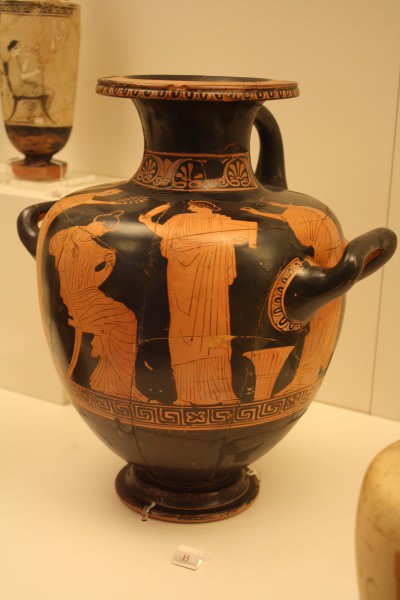
Red-figure Hydria
Hydria ( pl. hydriai) - used principally to store water and one of the commonest shapes in Greek pottery. Two horizontal handles were for carrying the vessel when full and one vertical handle used when pouring. They could also be used as a burial container for children. They were also often made in bronze versions.
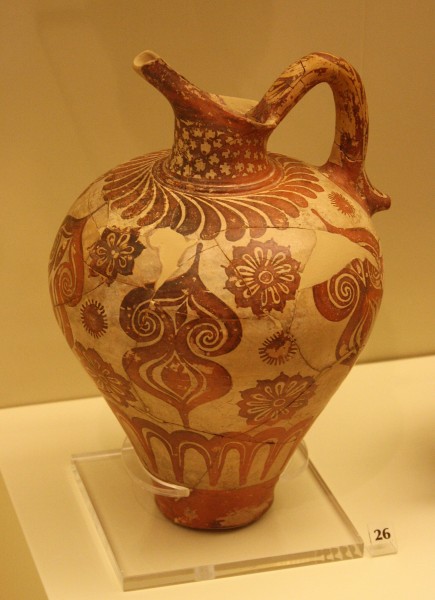
Mycenaean Jug
Jug - with a spout and single handle, used for pouring liquids.
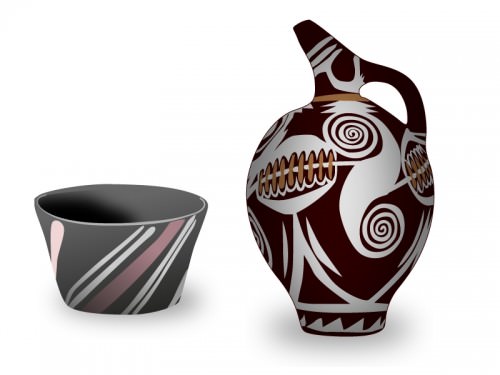
Kamares Ware Pottery
Kamares Style Decoration - a polychrome decorative style from the Minoan civilization using bold designs in red or white on a black background (c. 2000 - c. 1700 BCE).
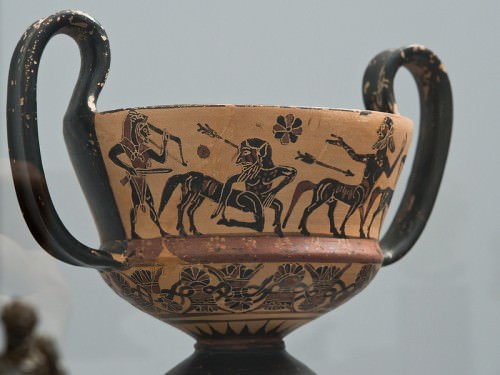
Black-figure Kantharos
Kantharos ( pl. kantharoi) - a cup with two large vertical handles and a stemmed foot.
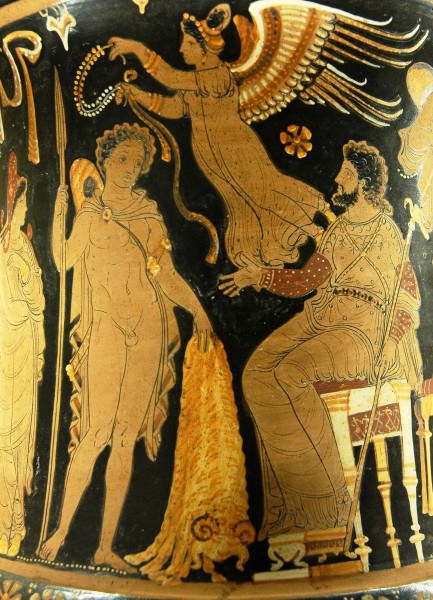
Jason brings Pelias the Golden Fleece
Kerch Style Decoration - named after the palce where many examples have been found they are decorated with distinctive gilded details in low relief. Originally form Athens.
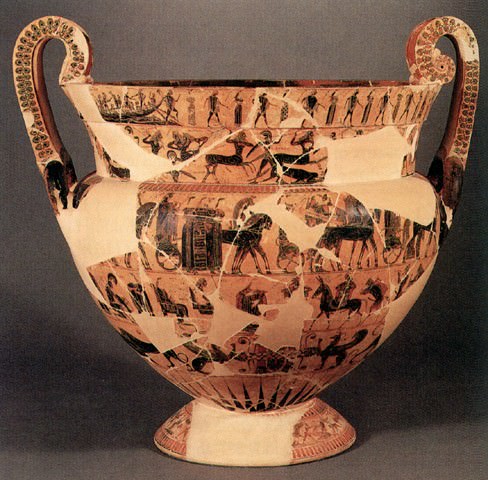
Francois Vase
Krater ( pl. krateres) - a large vessel with two handles, used to mix water and wine, usually to a ratio of 3:1 or 5:3.
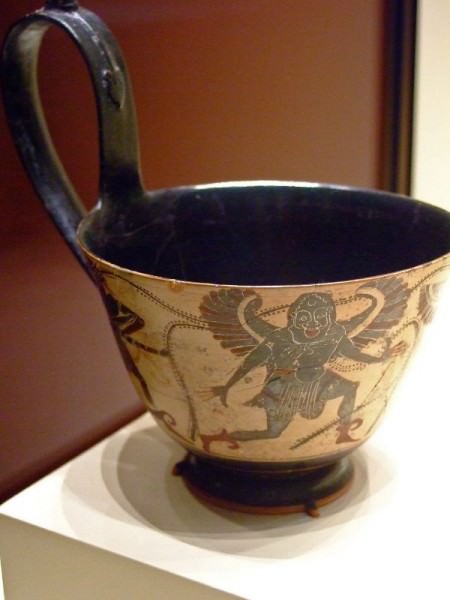
Attic Kyathos
Kyathos ( pl. kyathoi) - a ladle-like cup used for serving wine.
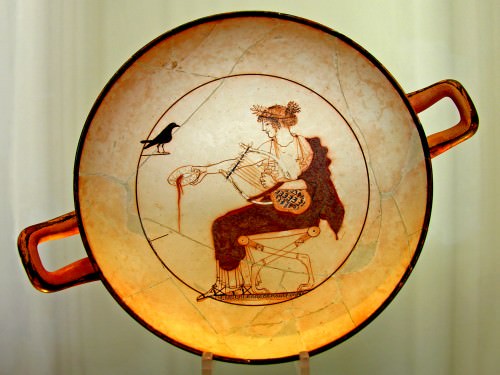
Apollo with Lyre
Kylix ( pl. kylikes)- a stemmed cup with two horizontal handles and a stemmed foot, used for drinking wine. One of the most common shapes in Greek pottery, over 30 varieties exist.
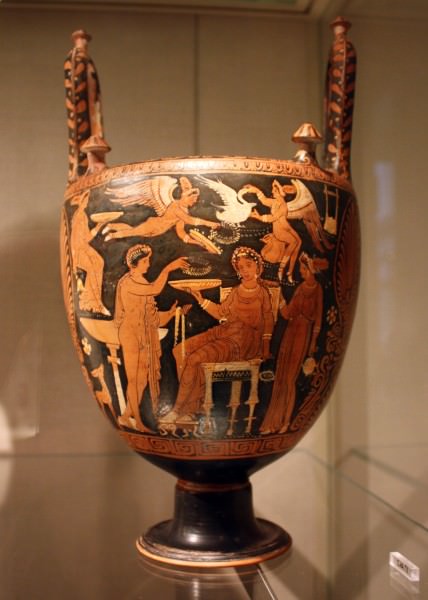
Lebes Gamikos
Lebes Gamikos ( pl. lebetes gamikoi) - a large vase with two upright handles often with a conical stand and lid. Used during marriage and burial ceremonies.
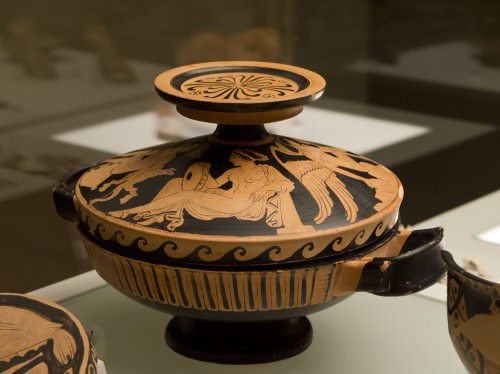
Attic Lekanis
Lekanis ( pl. lekanides) - a shallow vessel with a foot and two horizontal handles and often with a single handled lid. The dish was used for storage of small articles (especially for women) and for serving food (when the lid, overturned, became a second serving dish).
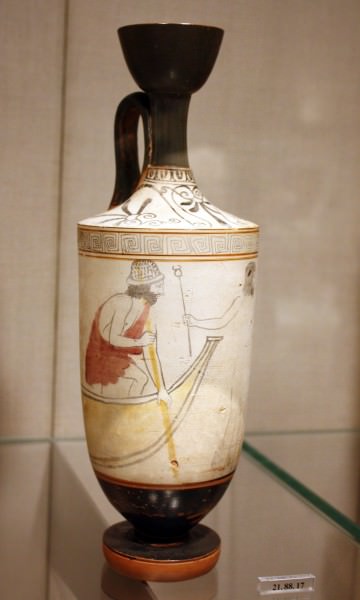
Attic Lekythos
Lekythos ( pl. lekythoi)- used to store fine oils and perfumes, often dedicated in burials and decorated in reference to this function, often with a white background.
Louterion ( pl. louteria) - a large basin vessel with two handles and sometimes a spouted lip. Used for holding water for washing or perhaps mixing wine and water. A third function may have been connected with funerary rites such as washing the body.
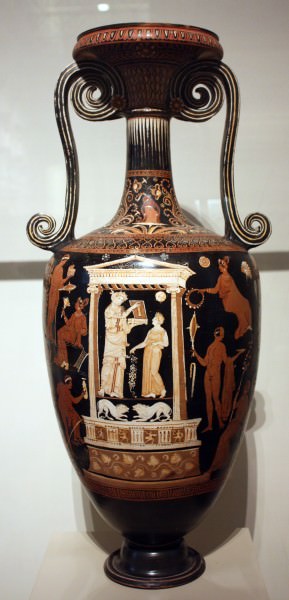
Apulian Loutrophoros
Loutrophoros ( pl. loutrophoroi) - a tall slim jar with elongated handles, used for holding water used in wedding and funeral rites and as a grave marker, especially when the deceased was unmarried.
Marine Style Decoration - found in Minoan and Mycenaean pottery with the depiction of sea-life, particularly octupuses, argonauts and shellfish (from c. 1600 BCE).
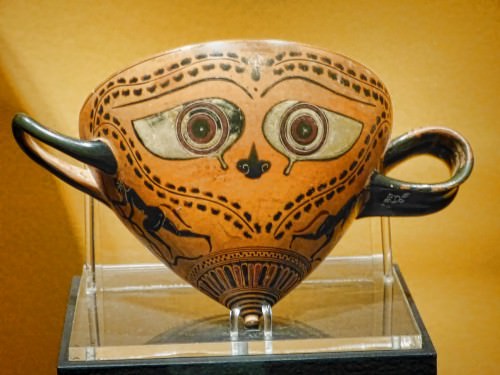
Etrurian Mastos
Mastos ( pl. mastoi) - a wine cup shaped like a female breast with a nipple at the base instead of a foot.
Neck-Amphora - an amphora where the neck joins the shoulder of the vessel at a sharp angle.
New Palace Style Decoration - the late Minoan decorative style using more stylisitc representations of plants and marine life (from 1450 BCE).
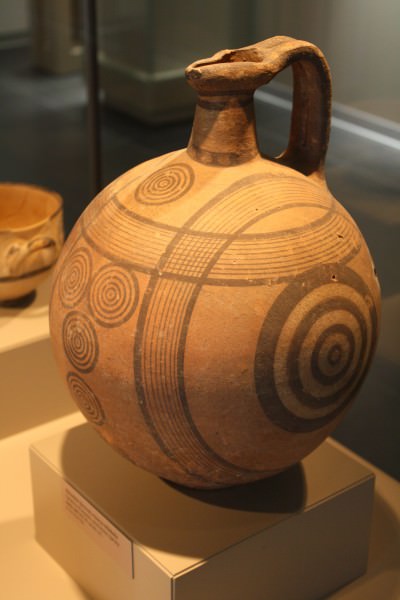
Cypriot Pitcher
Oinochoe ( pl. oinochoai) - jug or pitcher for pouring liquids, principally wine.

Greek Pottery Motifs
Ornament - decorative patterns and floral designs added to the foot, rim, handles and borders of vessels. Lotus, palmettes, ivy, meander, rays, tongues and rosettes were the most popular.
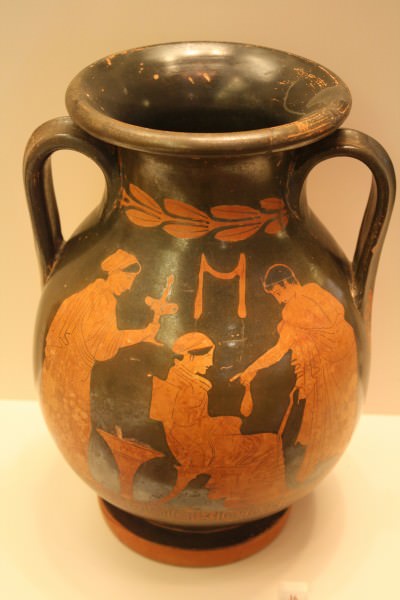
Red-figure Pelike
Pelike ( pl. pelikai) - a jar used for storing liquids such as oils and wines. Also used to contain ashes after cremation.
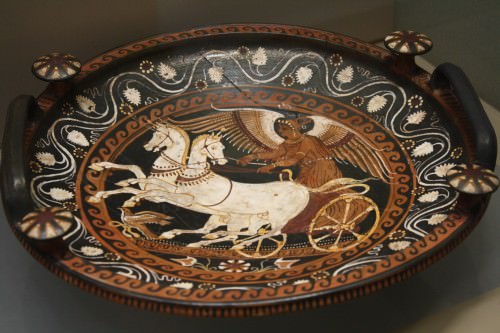
Nike
Phiale ( pl. phialai) - a shallow bowl used for wine and pouring libations in religious ceremonies. Often with an upraised knob in the centre which gives the vessel its name - omphalos (naval).
Pinax ( pl. pinakes) - a decorative plaque affixed to walls in tombs and temples.
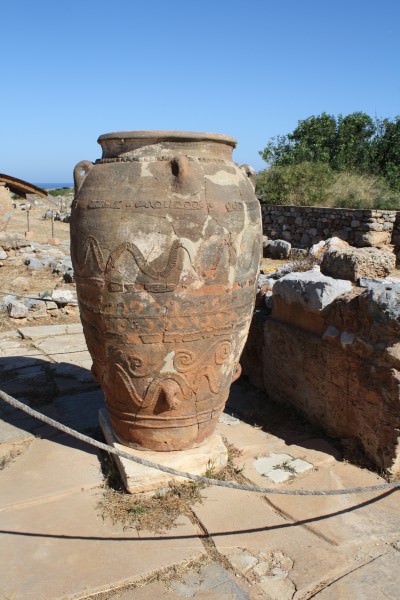
Pithoi
Pithos ( pl. pithoi) - from the Minoan civilization, a large jar for the storage of foodstuffs such as grain and olives. Large magazines of pithoi are a typical feature of Minoan palace complexes.
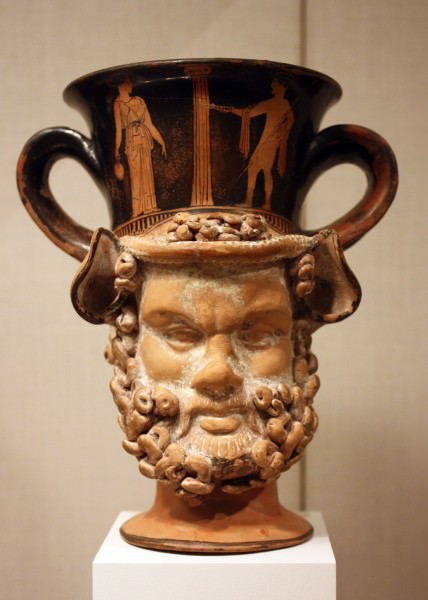
Satyr Kantharos
Plastic Vase - A vase which incorporates a small sculpture as part of the vessel.
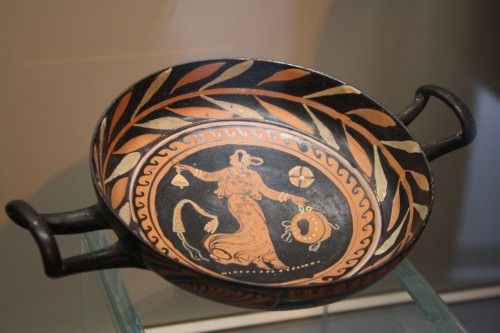
Maenad
Plate - a circular flat dish with a raised rim.
Proto-Geometric Style Decoration - with simple shapes such as spirals and solid black lines, a pre-cursor of the more ambitious Geometric Style (c. 1000 - 900 BCE).
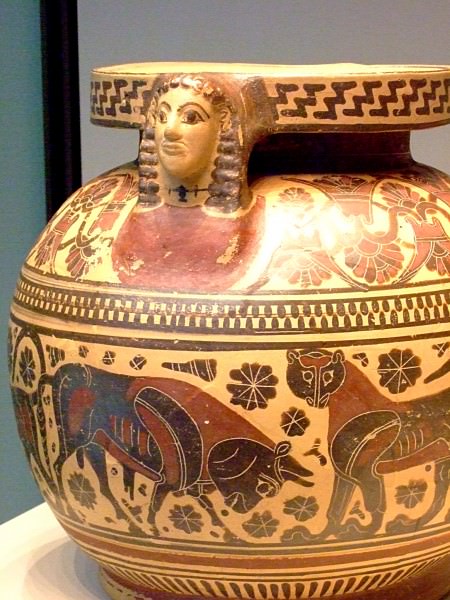
Corinthian Vessel with Protome
Protome ( pl. protomai or protomes) - three dimensional moulds added to vessels, especially handles. Often in the form of animals or the human upper body.

Attic Psykter
Psykter ( pl. psykters or psykteres) - a large vase shaped like a mushroom and used to cool wine. They could be placed within a krater or stand alone.
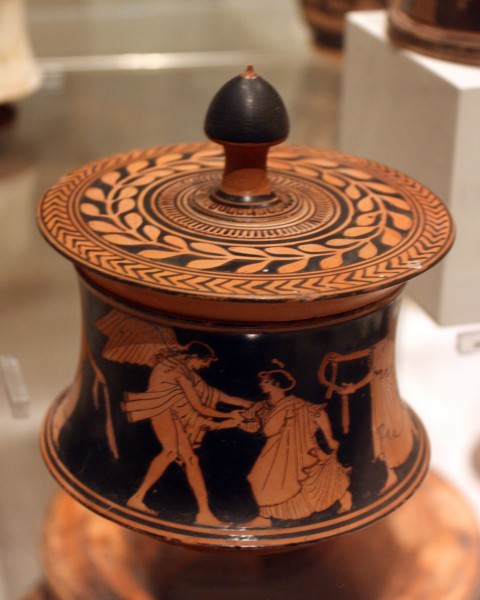
Attic Pyxis
Pyxis ( pl. pyxides) - a small circular box with a lid, often used for the storage of jewellery and toileteries.
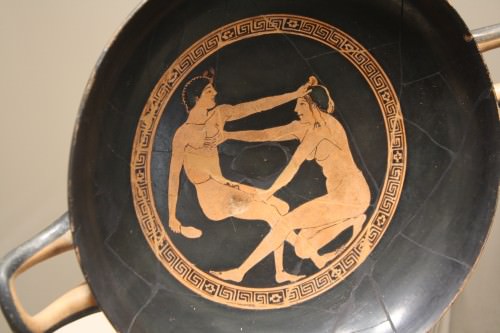
Greek Erotic Scene
Red-Figure Style Decoration (from c. 530 BCE) Replacing the earlier black-figure style, vessels were painted black to leave unpainted figures the red colour of the original clay. Details were then added to the figures using a fine brush. Much greater attempts were made at realism and perspective in this style.
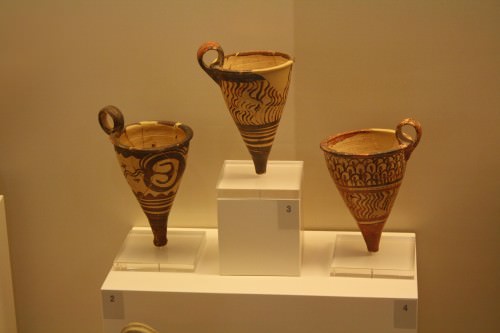
Mycenaean Rhyta
Rhyton ( pl. rhyta) - used in relgious practices for the pouring of libations, they may also take the shape of animal heads, especially bulls.
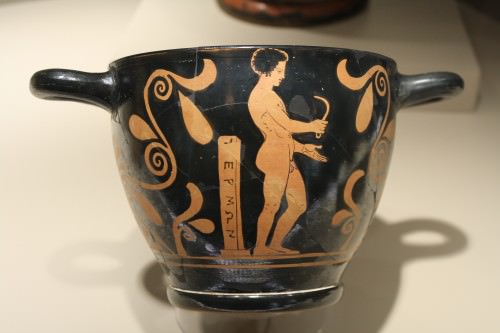
Greek Athlete With Strigil
Skyphos ( pl. skyphoi) - deep cup or bowl with two handles near the rim.
Squat Alabastron - a flat jar for storing creams and ungents, first appearing in Minoan Crete and popular in the Mycenaean period. Early examples were made from alabaster, hence the name.
Stamnos ( pl. stamnoi) - a jar with a wide mouth, often with a lid and two handles, used for mixing wine and water.
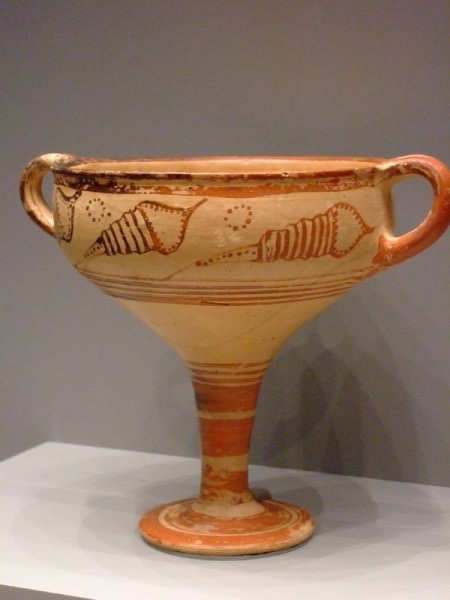
Mycenaean Stemmed Cup
Stemmed Cup - a drinking cup with two handles, a stem and base. Popular in the Mycenaean civilization, they would later develop into the unbiquitous kylix.
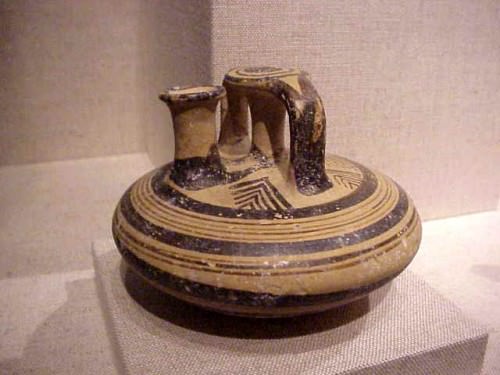
Mycenaean Stirrup Jar
Stirrup Jar - first appearing on Minoan Crete but the most common shape in Mycenaean pottery, with a false central spout, used to store wine and oils.
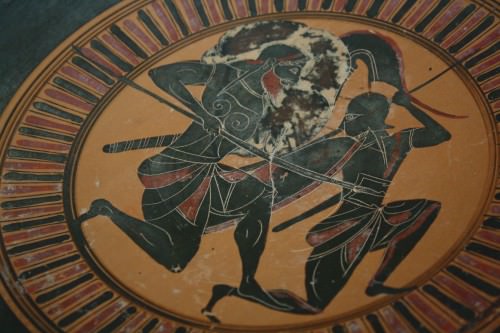
Black-Figure Tondo
Tondo ( pl. tondi) - the picture enclosed in a circle found on the inside of a kylix or plate.
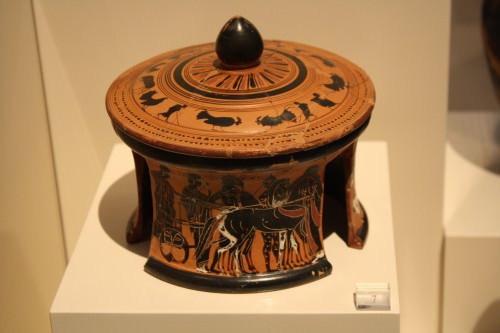
Tripod Pyxis
Tripod Pyxis ( pl. pyxides) - A pyxis with three concave legs, also called a tripod-kothon.
Vasiliki Style Decoration - the first distinctive Minoan style of pottery decoration using mottled red and black colours (c. 2600-2000 BCE). Named after the site where the first examples were excavated.
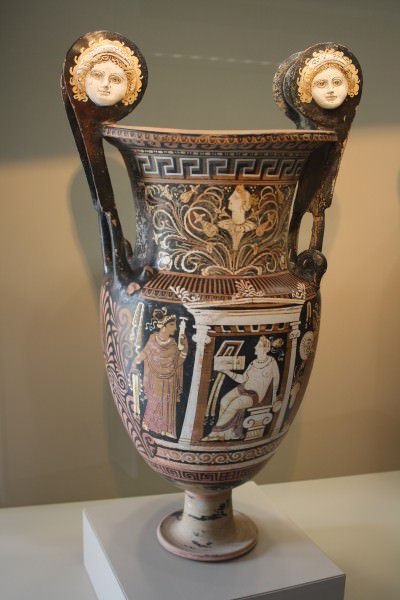
Greek Wine Krater
Volute-Krater - a krater where the tops of the handles have a volute or scroll. More commonly decorated in the red-figure style.
LICENSE:
Article based on information obtained from these sources:with permission from the Website Ancient History Encyclopedia
Content is available under License Creative Commons: Attribution-NonCommercial-ShareAlike 3.0 Unported. CC-BY-NC-SA License